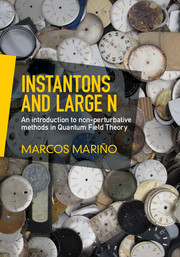Book contents
- Frontmatter
- Contents
- Preface
- Part I Instantons
- Part II Large N
- 6 Sigma models at large N
- 7 The 1/N expansion in Quantum Chromodynamics
- 8 Matrix models and matrix Quantum Mechanics at large N
- 9 Large N Quantum Chromodynamics in two dimensions
- 10 Instantons at large N
- Appendix A Harmonic analysis on S3
- Appendix B Heat kernel and zeta functions
- Appendix C Effective action for large N sigma models
- References
- Author Index
- Subject Index
9 - Large N Quantum Chromodynamics in two dimensions
from Part II - Large N
Published online by Cambridge University Press: 05 September 2015
- Frontmatter
- Contents
- Preface
- Part I Instantons
- Part II Large N
- 6 Sigma models at large N
- 7 The 1/N expansion in Quantum Chromodynamics
- 8 Matrix models and matrix Quantum Mechanics at large N
- 9 Large N Quantum Chromodynamics in two dimensions
- 10 Instantons at large N
- Appendix A Harmonic analysis on S3
- Appendix B Heat kernel and zeta functions
- Appendix C Effective action for large N sigma models
- References
- Author Index
- Subject Index
Summary
Introduction
In the toy models of the preceding chapter, we have studied theories in zero dimensions where the only degrees of freedom were matrix valued, i.e. gluon-like. However, some of the important insights of the large Nexpansion in QCD concern the quark sector, for example the properties of mesons. Is there a toy model where we can see quantitatively how the large Nexpansion works in this sector? Such a model was proposed by 't Hooft shortly after his pioneering paper on the 1/N expansion, and it is QCD in two dimensions. In this model, the pure gluon sector is now trivial, but the interaction between the quark sector and the gluon sector is very rich. 't Hooft noted that the planar diagrams for the quark–gluon interaction could be resummed, and he derived an integral equation which determines the large Nlimit of the spectrum of meson masses.
't Hooft's solution of planar QCD in two dimensions is not only a pedagogical illustration of the expansion: it is an analytic triumph, providing an exact solution of an interacting planar theory, and it is also a beautiful toy model for the strong interactions. Many of the ideas put forward by 't Hooft in this solution continue to find applications in the analysis of gauge theories, for example in recent investigations of interacting conformal field theories in three dimensions. This chapter will be devoted to a detailed presentation of some aspects of 't Hooft's solution to two-dimensional QCD in the large Nlimit.
The fermion propagator
We consider the standard QCD Lagrangian (5.3.1) in two dimensions. In this chapter we will use the rescaled fields (4.2.30), (5.3.6), but for obvious reasons of economy we will omit the hats. We will also omit the flavor indices, and we will assume that all the quark flavors have the same mass m. Note that, in two dimensions, the coupling constant g20 has the dimensions of a mass. Our conventions for the gamma matrices, in Minkowski space, are
- Type
- Chapter
- Information
- Instantons and Large NAn Introduction to Non-Perturbative Methods in Quantum Field Theory, pp. 274 - 300Publisher: Cambridge University PressPrint publication year: 2015



